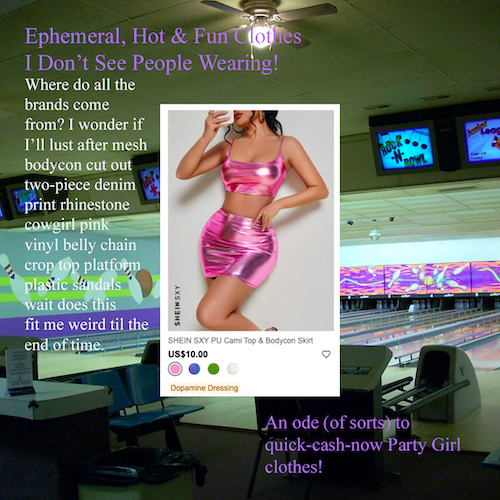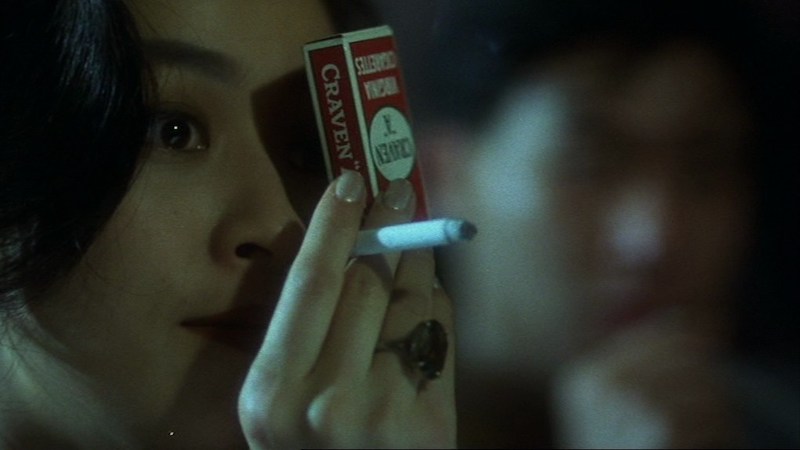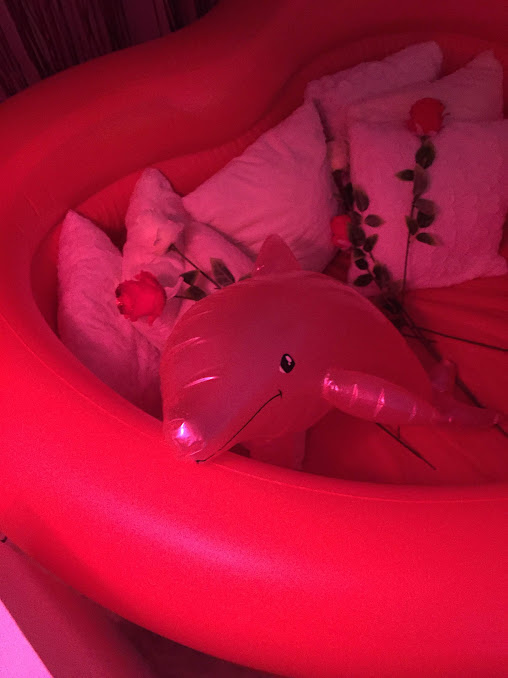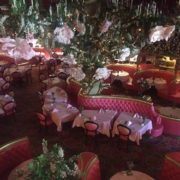
 A Mid-Afternoon Trip to The Madonna Inn
A Mid-Afternoon Trip to The Madonna Inn
Very Famous on the Road: A new column looking at the intersection of glam and fab in travel!

Italian novelist Umberto Eco in his essay “Travels in Hyperreality” called The Madonna Inn a “poor man’s Hearst Castle.” Apples and oranges, I would say! It’s simply a beautiful, crazy place—the phrase “poor man’s” anything has no room here—unless it’s a themed room sparkling with rhinestones!
Pink touches most everything in this cowboy-Californian Swiss chalet. It’s baked in gift shop receipts, bags, roses, booths, carpets, goblets, everything! In a cinematic gesture, The Madonna Inn first opened on Christmas Eve, 1958. The carpet was designed by a former Disney artist, according to The Madonna Inn blog—a great, pink and fun resource. And the roadside resort has been compared to Disneyland, which is a good go-to descriptive for anything created purely for pleasure (and money, of course!)

The New York Times, which tries to acknowledge kitsch in its own way, warned in its 1982 “California’s Oddball Hotel” story that, “People who do not like excess are hereby warned to stay away.” Thank goodness certain people got that warning because, before then, the people who didn’t “get it” apparently complained until the pink bread went away.
The day I visited with Very Famous friend Hilary, of Cartoons by Hilary fame, it was quiet at the San Luis Obispo rose castle. The hotel/motel Eco described as not being able to be described—at least not by “the poor words with which natural human speech is provided”— was mostly quiet, some of its nooks suffused in mid-afternoon light reminding you that this is a place on Earth. The café and gift shop attendants were pleasant and quiet, a nice “hello” offered in the manner of people used to groups of people walking in and out, likely buying or eating not much, just snapping photos.

As we walked around taking many, many photos, there was soft big band music playing in the grand, pink—and delightfully day-time empty—dining room of Alex Madonna’s Gold Rush Steak House. It was, for a few minutes, our empty movie set!
People often feel like they have to explain away “too much” with words like “savage,” in the case of this 1982 New York Times article, or other descriptions inviting unrestrained sensibilities. But I suppose part of being an adult out in public is pretending to show restraint when called upon. Thank goodness for places like Meow Wolf and The Madonna Inn that have helped disabuse us of that notion when it involves art and us.

Alex Madonna, along with his wife Phyllis, dreamed up the Madonna Inn on the back of a napkin. No architect was apparently needed, though famous modern architect and friend of the Inn Richard Neutra said that no architect would have allowed Madonna to build all those angles. Sometimes you just really don’t need an architect! Phyllis decorated each room with pieces she found while shopping in Beverly Hills in the Robertson Boulevard district. The result was each room with its own world and its own name—the Caveman, Cloud Nine, Jungle Rock, and Hearts & Flowers, etc. It is the specific dreamland that could result only from two imaginative Swiss-Italians who struck gold in cattle and construction along the California coast—pure American optimism.
There are 110 rooms, all making grand use of cave rock, animal print, glitter, pink carpet, ornate Victorian furniture, roses, waterfalls, wagons. The Merry Room, I’m particularly drawn to, with walls made of pink glitter, red doors, and gold light fixtures.
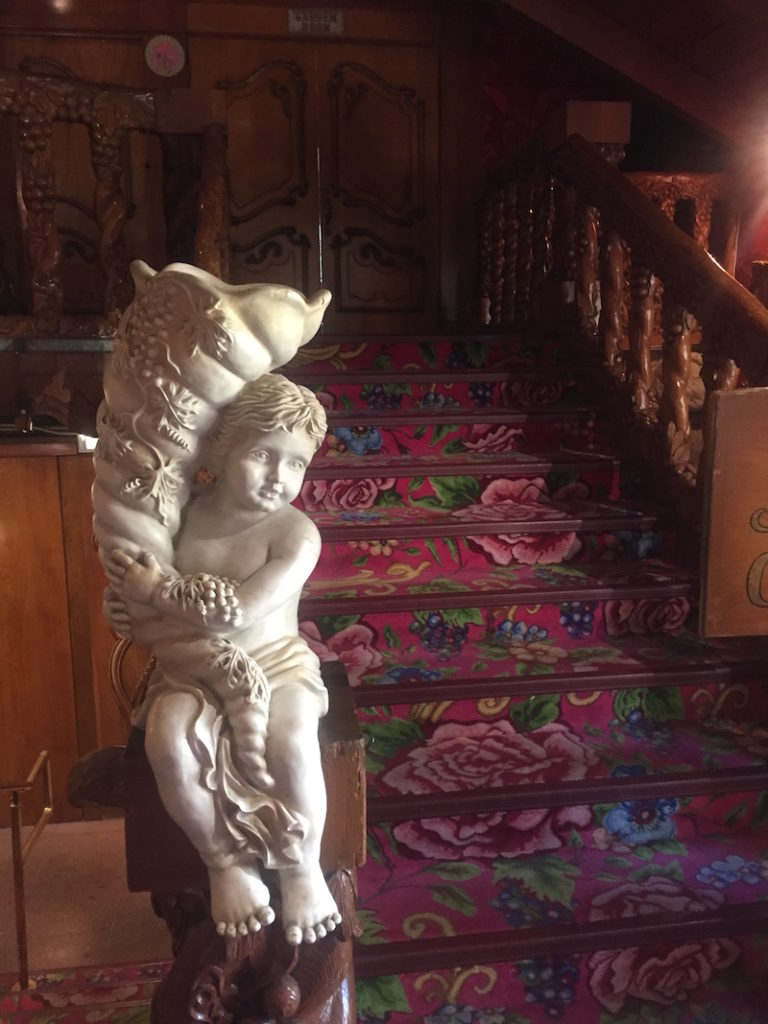
The Madonnas loved rocks and the color pink, a pairing that makes complete sense for any cowboy family. It’s a place built for pleasure, for anyone who’s wanted to escape sun, highways, and grass for sumptuous textures, darkness, and color. “Chopin’s Sonata in B flat minor sung by Perry Como in an arrangement by Liberace and accompanied by the Marine Band,” Eco said was almost the right description. Here’s another I enjoyed: “Calvino’s Invisible Cities described by Judith Krantz and executed by Leonor Fini for the plush-doll industry.” And if you’re aware but unread like me, that translates to: a philosophical garden conversation about cities as thought experiments described by a very popular romance novelist and lived out by an Argentinian surrealist painter via stuffed animals.
“Look up” almost never fails to be good advice, and that’s what I would say to do upon first walking in the Madonna Inn. Look up, then slowly cast your eyes down to the pink-and-gold booths, the rose-patterned carpet, then back up again to see the Victorian dolls swinging. It will all make you very, very happy to see.

Things not to miss: Try not to miss anything, of course, but look out for the swinging dolls, the waterfall urinal in the men’s room, their signature Pink Champagne Cake, and if you’re so inclined, purchase one of their famous goblets, designed by Alex Madonna and currently manufactured by Ohio’s family-owned Mosser Glass.
Categorised in: Features, Glamour
